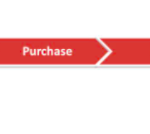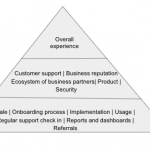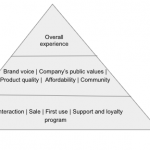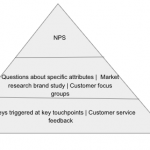Two things are true: 1) customer experience is important (two-thirds of companies now compete primarily on CX) and 2) customer experience is sprawling. It covers product and service and brand and more. Visualizing and prioritizing a structural approach can help. That’s where the CX pyramid comes in.
According to Gartner, successful customer experience projects start by focusing on how they collect and analyze customer feedback. We worked with Joshua Rossman, VP of CX at Oracle and advisor to 30+ startups in Silicon Valley, to explore how he thinks about it.
What is a customer experience pyramid?
The concept of a “customer experience pyramid” can mean 2 different things. It can either be a way to evaluate individual parts of CX or a way to visualize all of the different parts together.
The former was introduced by Gartner in 2018 as a method for categorizing customer experiences by impact. Like Maslow’s hierarchy of needs, the general idea is that the bottom layer meets the most basic expectations while the top offers the deepest fulfilment. Gartner recommends applying the pyramid to every customer touch point (sale, service interactions, etc.) individually to see how well you’re delivering at each stage.
The second type of pyramid works more like a customer journey map, except that it has more dimensions. It’s designed to encompass the customer experience as a whole—bringing all the pieces together to make them easier to understand. This type of CX pyramid, used by Joshua Rossman, VP of CX at Oracle, also makes it easier to measure customer experience.
The customer journey map vs. the customer experience pyramid
Some companies have customer journey maps that stretch across whiteboards and around walls like a bulletin board from a detective movie. Others restrict themselves to “awareness,” “purchase,” and “advocate.” Either way, the depth and style of touchpoints varies dramatically from business to business, and customer journeys are almost never purely linear.
Most companies develop a journey map that spans from the customer’s initial shopping experience onward, like this one courtesy of CustomerThink’s analysis of 200+ CX initiatives.

But there are many aspects of customer experience that span across touchpoints. For example:
- Brand
- Customer service
- Digital interactions (site, mobile, etc.)
- Pricing and pricing models
- Communications and marketing
At any point during their research, purchase, or product use, a customer may need to use your website or mobile app. At any point, they may be influenced by your pricing or subject to billing changes. According to Forrester, unfavorable news stories can even influence the ratings that customers give your customers service agents negatively. In other words, it’s all connected.
Visualizing your customer experience as a pyramid has another benefit: organizational alignment. According to our survey of CX professionals, just 20% reported that customer experience is deeply embedded across all levels of the organization. And, 67% reported that their organization has multiple customer experience leaders, each responsible for different parts of the customer journey.
Considering your entire customer experience as a whole can make it easier for everyone to understand how the pieces fit together.
How to build your own CX pyramid
There are 2 steps to building a CX pyramid for your company: 1) identifying the various aspects of your customer experience and 2) figuring out how to assess their impact.
Part 1: Visualizing the pyramid
To create an effective CX pyramid, you need to take all the pervasive elements of CX and combine them with your customer journey map. Items at the bottom of the pyramid are not less important than items at the top—they are simply more specific.
The base: The base of your pyramid should be made up of specific customer touchpoints—the ones you think are most important for your customers and your brand. These might include journey points like point of sale, customer support interactions, and trying a particular feature.
The art here lies in prioritizing the right points. Regardless of whether you’re a B2B company or B2C, CX experts tend to agree that more than 10 touchpoints on a customer journey is too many. You want to be comprehensive in your initial audit, but it’s equally important to focus on the things that matter.
The middle layer: The middle layer is less about individual interactions and more about general experiences like customer service, brand, and product. These are areas where you need to meet basic expectations, but also have a chance to differentiate yourself.
Top layer: This is your “true north”—the least specific area and refers to your customer experience overall. How do your customers feel about your company as a whole?
Here are some examples of a potential CX pyramid for a B2B and B2C company.
B2B

B2C

Part 2: Using the CX pyramid for measurement and analysis
Once you have your CX pyramid established, you can tier your feedback the same way—from the highest, most overarching understanding of customer experience down to the most granular, by tying each section of your original pyramid to a source of feedback.
Here’s the type of pyramid that Joshua might use.

Tier 1
If you work in CX, odds are that you’re already in a committed relationship with the top of your CX measurement pyramid—Bain’s Net Promoter Score®. (Hint: you can also use SurveyMonkey’s free NPS calculator to understand yours when your responses are in.)
Tier 2
General customer satisfaction surveys sent at regular intervals can be incredibly illuminating if you include questions about brand attributes. These are matrix-style questions that ask customers to evaluate your company based on 6-10 different factors.
Examples of brand attributes might be: product innovation, affordability, ease of use, ethical company practices, range of services, etc. These are extremely helpful to know when a CEO asks “Why did our NPS go down?” More importantly, they tell a broader story than just NPS. These questions (which should be limited to 1-3 per survey because they take some time to answer) can illuminate your changing customer experience over time.
The rest of your feedback metrics will vary depending on the different aspects of your customer experience and which parts you have the resources to pursue.
Tier 3
Triggering surveys automatically after customers do a particular action can be an easy way to cover a customer touchpoint consistently. SurveyMonkey’s Zapier integration makes that easy. You can also simply send them as follow-up emails.
Not all of your CX feedback data will flow in at the same time. Customer service responses might come faster than you can collect it. Brand-level market research, which is usually overseen by your marketing team, might only come in once per quarter—or less. That’s okay. As long as you’re getting feedback semi-regularly and keeping it in a central place, you’re perfectly positioned to get the right insights.
As you put feedback programs in place, you probably want to prioritize measuring the parts of CX that you think have the biggest impact for your customers. That’s the right thing to do. But remember the anecdote from Forrester about bad PR and lower customer service scores! Customer feedback is most effective when considered as a whole.
Using the CX pyramid to track success
Businesses don’t operate in silos, and customer experience trends aren’t usually isolated to one single aspect of the business. Tracking the various aspects of the CX pyramid together can help you avoid falling into the trap of ascribing changes to the wrong causes or failing to see success that actually exists.
The CX pyramid can be a good way to visualize results so that all stakeholders can see what’s changing and how those changes are influencing the overall customer experience. Having a shared dashboard means clearer alignment and—hopefully—fewer meetings spent debating priorities. Cheers to that.



